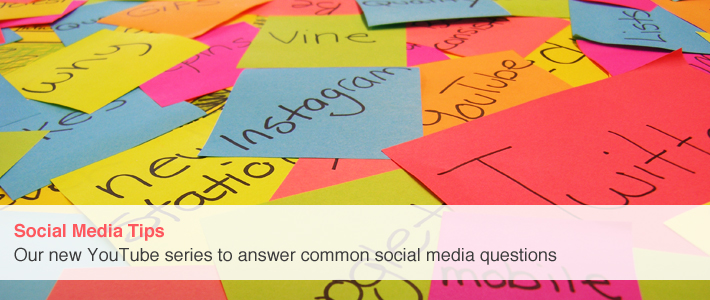
Episode 4: “How Should I Use Hashtags?”
Learn practical advise to keep in mind when using and creating hashtags.
If you have a social media question or an idea for a future episode e-mail Jessica@machteldfaasxander.com or tweet us.

Episode 4: “How Should I Use Hashtags?”
Learn practical advise to keep in mind when using and creating hashtags.
If you have a social media question or an idea for a future episode e-mail Jessica@machteldfaasxander.com or tweet us.

In the past few years, two opposing social media giants have emerged in the ongoing war for online popularity: Twitter and Facebook. Instead of focusing to create the best user experience possible, Twitter and Facebook have prioritized competing with each other in an arms race. Both companies are acquiring platforms and apps to become social empires.
Last year, Facebook acquired Instagram, the popular photograph-sharing app for a considerable one billion dollars. A few months later, Instagram disabled support for Twitter cards, meaning that Instagram photographs could no longer be viewed in Twitter but would link to Instagram. Rather than trying to provide a better experience for Instagram, they created a more frustrating experience for Twitter.
Twitter acquired Aviary, a photograph-sharing app, and introduced photos to Twitter. While the ability to share photographs in Twitter was sorely needed, the filters for these photographs were not. Twitter only offers nine options and the filters do not enhance photographs to make them more visually appealing. Twitter has not spent the same time or resources developing their filters that Instagram has, and it shows.
Twitter acquired Vine, a video-sharing app, and announced that Vine videos could be viewed in Twitter. Twitter is known for short and to-the-point posts so the introduction of Vine’s six-second videos was a logical fit. Users were excited about the new platform and Vine gained popularity.
Last week, Instagram announced that the app would now support video. Video does not compliment Instagram the same way that it did with Twitter. Instagram was born as a photography sharing platform. All interactions centre around a photograph. There is not even an option to message Instagram accounts, only to comment on their photographs. Instagram’s tagline is “Fast beautiful photo sharing.” The photographs have always been the center of Instagram. Instagram did not add video compatibility to improve their users’ experience. They added the video feature to compete with Vine.
Many of the Instavideo features were improvements over Vine. For example, Instagram allows users to choose which image will represent the video. They also provide filters for the videos and allow users to delete unwanted footage. Various online social articles applauded these features and Instavideo.
Soon users starting complaining that having videos in their stream was annoying. The 15-second videos were not what they wanted while using the platform and were too long. The videos were distracting from rather than enhancing what those users loved about Instagram, sharing filtered photographs with their family and friends. Despite your opinion on the videos in your Instagram stream, there is one significant problem with the update.
Never before had I lost an image because of an Instagram crash. I considered Instagram a reliable app. The day that Instavideo was released, I had the app crash four times. I lost three separate videos in my attempt to upload them. One video that did upload had mangled audio. Since then, even while viewing my stream, I will have the Instagram app crash and shutdown.
I soon discovered that I was not alone. I came across many frustrated users complaining about Instagram crashing and losing their posts before they were uploaded. Hopefully Instagram fixes these bugs. Even if they do, they released the update before it was bug-free to compete with Twitter and Vine.
Instavideo did not improve the Instagram experience.
Instead of focusing on what that particular social platform is good at and loved for, some are letting the competitive social atmosphere dictate what they offer. “They offer this, so we have to offer it too.” These social platforms are losing their sweet spot.
Rather than having many great platforms and apps, we are moving towards a trend where platforms do everything, but nothing well. Instead of leading the way to develop new and innovative updates, they are reacting to one another. Effort, time and resources that could be spent to further improve what a platform is loved for are now being used to weakly imitate what other services already offer in an attempt to dissuade others from using competitors.
When user experience is no longer priority, we all lose.

Our friends at Axonify are awarding $5000.00 to the winner of their current contest. Axonify games are designed to train employees on almost any topic while making learning enjoyable. They are awarding $17 000.00 in total prizes up for grabs.
If you can build an addicting game, that $5000.00 could yours.
More details on their website.

Episode 3: “Should I Schedule My Social Media Posts?”
Learn the benefits and dangers in scheduling your social media posts to decide what is the best decision for you and your brand.
If you have a social media question or an idea for a future episode e-mail Jessica@machteldfaasxander.com or tweet us.
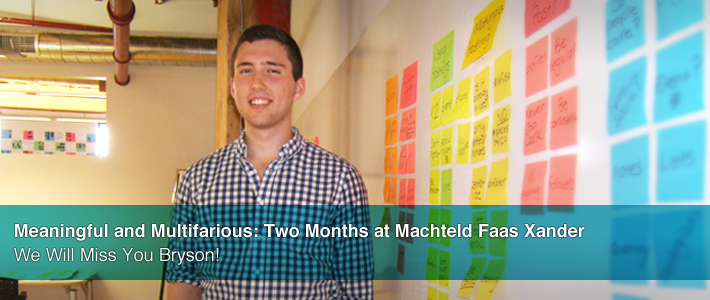
When you think of an internship, what comes to mind? Is it countless hours of data entry? Getting coffee for the boss? Being dead last in the office hierarchy? My internship at Machteld Faas Xander was anything but. Let’s start with the space itself. Forget the drab interiors of your typical office building. Located in the reclaimed Lang Tannery building in Downtown Kitchener, visitors to the MFX office are first greeted with a fleet of Plasma Cars. Need to get someone’s attention? No bells here, try honking the old fashioned horn instead. The original factory floor and ceiling are sharply contrasted by a healthy serving of glass and splashes of neon pink, green, and blue. Sticky notes abound, and the creative desk arrangements are a far cry from your standard office cubicle. Convention doesn’t exist here, and, if I’m not mistaken, they like it that way.
Let’s move on to the work I did. I would describe my time at MFX in two words: 1) meaningful and 2) multifarious. I’ll begin with meaningful. One of the first conversations I had with Rebecca was about what I could expect to be doing during my internship. She told me that one of her goals was to have me contribute directly to a project and to see it through from start to finish. I was immediately struck by this notion in a profound way. It was empowering to know that my employer wanted me not just to help out with a project or two but to be able to take some ownership over the end result. This became apparent during our work with Guelph Region and the Ontario Ministry of Research and Innovation where we facilitated a number of sessions in order to help complete the Guelph Regional Self-Assessment Handbook, a document intended to improve entrepreneurial services across the province. I attended meetings with representatives from different organizations in Guelph, was directly involved with the facilitation sessions, and was trusted with directly contacting important stakeholders. Being given direct input on the project made it a much more meaningful experience for me.
Working with Waterloo City Council to create their Vision for Uptown is a second example of meaningful work. At a Council Meeting, the mayor and council members were presented with over 30 projects taken by MFX from a number of documents detailing the future of Uptown Waterloo. Together, the councilors selected their top 10 projects that will soon be appearing in the Uptown area. Knowing that I will be able to walk through Waterloo and see projects that I was able to contribute to makes it a meaningful experience for me. It was also rewarding to see the diversity of projects selected by the Waterloo City Council, which brings me to my next point, the multifarious nature of my work at Machteld Faas Xander.
Varied, multifarious, and dynamic are all words I would use to describe the work I did. From Regional Self Assessments to Council’s Vision for Uptown, from technology and operations departments to researching nanotechnology, my two months at MFX were diverse, to say the least. As a strategic design and communications consultancy, MFX has run the gamut when it comes to projects. This much was clear to me when in two months I worked on five distinct projects. Two months has given me just a small taste of life at Machteld Faas Xander. A regular internship, it was not. I have enjoyed every minute of my time spent working with John and Rebecca and the rest of the team. Passionate Creative People could not be a more fitting slogan. I hope to be back again soon.

Episode 2: “How often should I post?”
Here are some principles to help you decide how often you should be posting on social media for your brand.
If you have a social media question or an idea for a future episode e-mail Jessica@machteldfaasxander.com or tweet us.
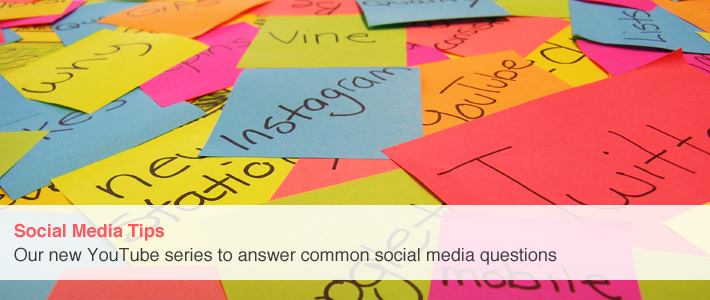
Here is the first episode of our new YouTube series to answer common social media questions. Learn about EdgeRank, the algorithm Facebook uses to determine what posts appear in user’s newsfeeds and for how long, and how to get your message to more people.
Episode 1: Facebook EdgeRank
“I posted something on my Facebook page but my friends say they didn’t see it. What happened?”
If you have a social media question or an idea for a future episode e-mail Jessica@machteldfaasxander.com or tweet us.
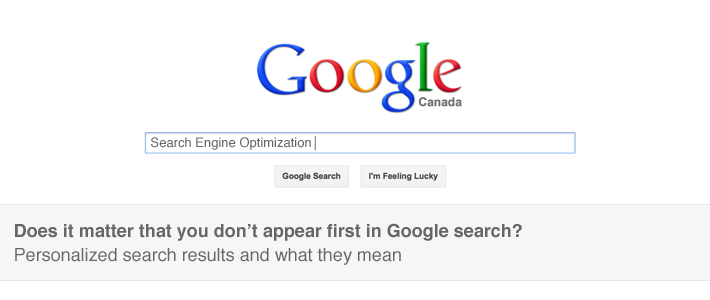
“We’re the 3rd Google result for our industry.”
We work with companies to help them understand Search Engine Optimization (SEO). Often, we hear some variation of the quote above. Many gauge their SEO success based on checking a personal computer to see where they rank in keyword searches.
This is problematic.
Google uses complex algorithms and personalized search results to determine which results appear. Google automatically takes a variety of your personal information, such as, your location, search history, browser choice and so on, to determine what results appear. When using Google search,your results are customized for you. Someone on another street, in another city or in another country is seeing different search results when searching the exact same words. A friend had recently done considerable research for an upcoming vacation. When we asked her to Google ‘Turkey’, her results were mostly about tourism options in that country. Another friend is interested in politics and world conditions. His results came up with information about politics and civil unrest in Turkey. Although they both searched for “Turkey”, the results were different.
How does this apply to businesses? Let’s say you own a business and want to improve your company’s SEO. When checking search results on your personal laptop, what will Google see? Let’s check just two variables.
Location: If you are searching from your desk, Google will notice that you are located near your business.
Search history: Likely, you have been on your company website before, probably many times. Google keeps track of this history and realizes we often want to go back to the webpages that we have visited before.
These two factors will alter where you rank in search results compared to your prospective customers searching your industry, across town.
Personalized search is useful for finding what we want fast. But do we want Google deciding what we want to see? Knowledge is power. By restricting our research results to what we have wanted to see in the past, we are often limiting what we see to what we already know. If we aren’t taking in new information, we become less capable of critically analyzing our environment. Personalized search results may be convenient, but does it help us in the long run?
Sometimes, what we want to see is not what we need to see.
What can I do? There are methods to disable personalized search, to a degree. By deleting browser cookies, your searches will temporarily be without Internet history bias.Google also offers a ‘Disable customizations based on search activity’ setting. However, there are still other factors being used to personalize your search results.
The best way to broaden our knowledge is by getting information from a variety of sources. Whether this is searching for your industry keywords on a library computer or getting information from Twitter, television, radio and online newspapers, we benefit from widening out in the sources we use.

We want to send out a big thank you to everyone who submitted a pet photograph for the May Storytelling Contest. There were so many great entries that choosing a winning photograph was difficult. The photographs were beautiful, stunning, funny and adorable.
Congratulations to Scott Rowland for having taken our winning photograph! Although the winning photograph was not the most aesthetically beautiful of the entries, at MFX we are suckers for a great story. Everyone who saw the entries laughed at Millie and loved the story behind her photograph.
Scott Rowland and Millie’s Story:
We hadn’t owned a dog in over 12 years, but in December we took the proverbial ‘plunge’ and purchased an 8-week-old Hungarian Viszla. Early on we set strict rules for our house management of the dog. Rule #2 (because everyone knows what Rule #1 is when you are housebreaking a dog), is that the dog is not to be allowed upon the furniture. Millie the Vizsla began testing this rule early and often upon her arrival but our crack team of internal trainers (6 in total) continued to be diligent in instructing Miss Millie where she was allowed and where she was not welcome. After several weeks of said training, my wife called me to the TV room to ask for my expert advice and ultimate ruling of Millie’s latest attempt to ‘find common ground’ with the discipline team. In the photos you find our Vizsla, fast asleep while standing on the floor and still resting on the couch. After several minutes of discussion, we were unable to decide whether this showed uncommon restraint for a 4-month-old pup or this was the beginning of years of pushing the envelope, normally reserved for teenagers. We ruled to let her complete her nap. You be the judge.
Because of the overwhelming amount of great entries, we had to share some of the other photographs that we particularly loved.



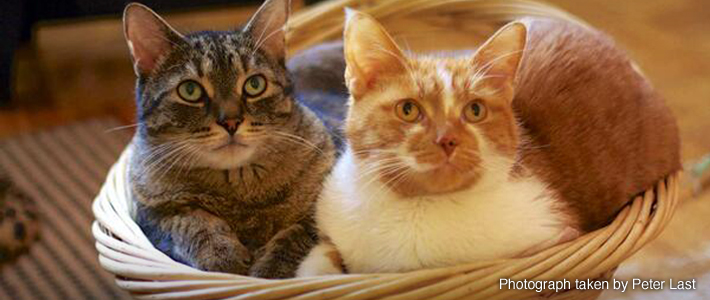

Jessica, our Social Media Specialist, has recently been volunteering with a few organizations to answer questions about social media. The success of these events has given us an idea. Tweet or e-mail (Jessica@machteldfaasxander.com) us your social media and online communications questions. We will be creating a series of short YouTube videos to answer the most common ones. Each video will be dedicated to answering a single question. If the question has a short answer, we will either respond with the answer or save it for a multi-question video.